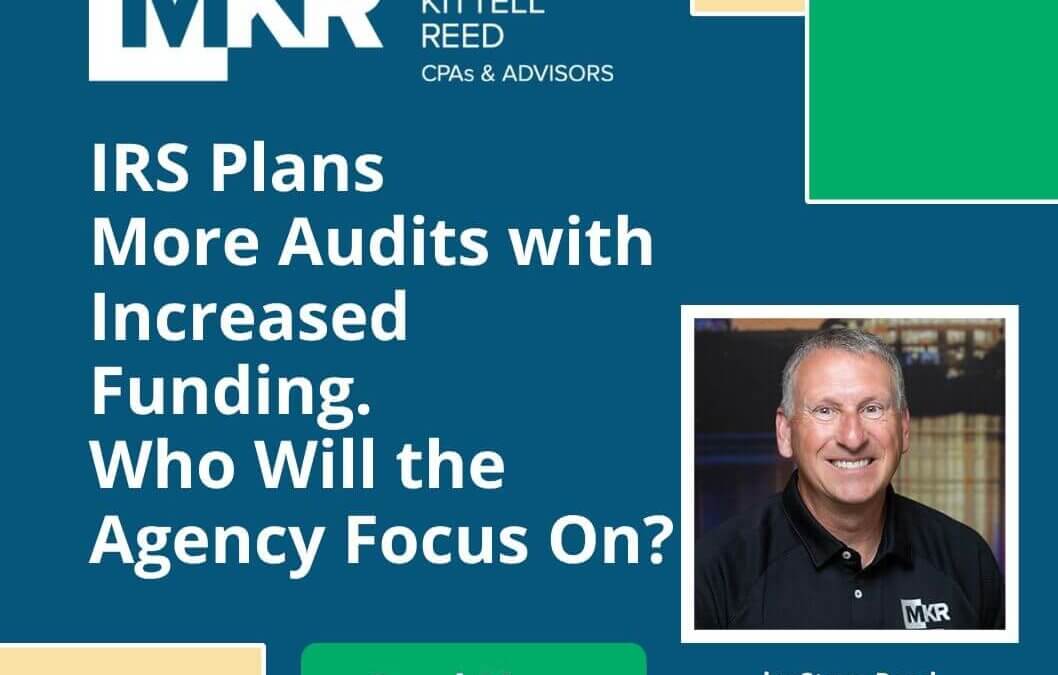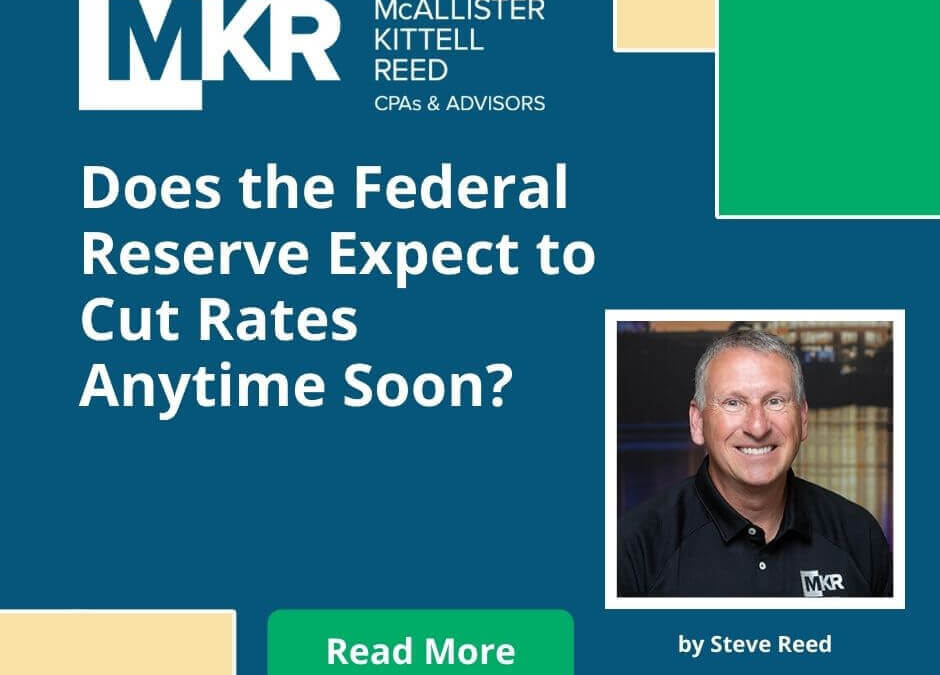
by Stephen Reed | Accounting News, Audit and Accounting, IRS, News, Newsletter, Small Business
The Internal Revenue Service (IRS) has recently announced a significant increase in the number of audits it plans to conduct in the coming years. This development is part of a broader initiative aimed at improving tax compliance and closing the tax gap, which is the difference between taxes owed and taxes paid on time. As a taxpayer, understanding who the IRS plans to target with these audits is important. Here’s what you need to know.
The Inflation Reduction Act
The Inflation Reduction Act (IRA), which was signed into law in 2022 by President Biden, granted the IRS $80 billion in new funding. The goal of the funding is to bolster an agency known for lengthy processing delays, a drop-off in audit rates, and major customer service shortcomings.
Over the next three tax years, the IRS plans a sharp increase in audits, but the agency insists these audits won’t affect taxpayers who earn less than $400,000 annually.
Focus on High-Income Earners
The IRS plans to focus on individuals earning $400,000 or more annually. This demographic has historically been associated with more complex tax returns, which can include multiple income streams, investments, and deductions. The IRS’s goal in focusing on high-income earners is to ensure that these taxpayers are accurately reporting their income and paying the correct amount of taxes.
Large Corporations
The IRS plans to triple the audit rates on large corporations with assets totaling more than $250 million. By tax year 2026, audit rates for these companies will rise to 22.6%, up from 8.8% in 2019. Additionally, large partnerships with assets totaling more than $10 million will be subject to significant audit rate increases, rising to 1% in tax year 2026 from 0.1% in 2019.
Small Businesses Potentially Under the Microscope
Despite initially assuring small business owners that the increase in audits won’t affect small businesses, some evidence is signifying otherwise. The Government Accountability Office, a nonpartisan agency, reported that more than 90% of audits are on families and small businesses below the $400,000 income threshold. In March, when Treasury Secretary Janet Yellen was asked by the House Ways and Means Committee about the number of new audits funded by the Inflation Reduction Act, she confirmed that the proportion of new audits targeting those families and small businesses would remain at the historical level of 90%.
Cryptocurrency Transactions
With the rise of digital currencies, the IRS is increasing its efforts to audit taxpayers involved in cryptocurrency transactions. This includes gains from the sale of cryptocurrencies, mining activities, and even receiving cryptocurrencies as payment for goods or services. If investors do not comply with reporting requirements, the IRS could impose accuracy penalties. Therefore, investors should maintain detailed records of all cryptocurrency transactions.
Offshore Accounts
Taxpayers with offshore accounts and foreign assets are also on the IRS’s radar. The Agency has long focused on foreign income and assets due to the potential for significant tax evasion. The Foreign Account Tax Compliance Act (FATCA) requires U.S. taxpayers with foreign financial assets exceeding certain thresholds to report these assets to the IRS. Failure to comply with these reporting requirements can result in substantial penalties. The boost in funding will allow the IRS to continue an aggressive pursuit of individuals and businesses attempting to hide income and assets overseas.
Preparing for a Possible Audit
Given the IRS’s focus on these areas, taxpayers need to ensure their tax returns are accurate and comply with all applicable laws. Keeping thorough records and documentation can help in the event of an audit. Consulting with qualified tax professionals can also provide guidance and help mitigate the risk of errors on your tax return.

by Stephen Reed | Accounting News, Business Growth, Industry - Professional Services, News, Newsletter, Professional Services, Small Business
Scaling a professional services firm presents unique challenges. Growth plateaus—periods where growth slows or flatlines—are common. Overcoming these plateaus requires strategic planning and execution. Here are actionable strategies to help make your business more predictable and scalable.
Understanding Growth Plateaus
Growth plateaus often occur at predictable stages in a firm’s lifecycle: after the initial expansion, businesses often struggle to scale operations without compromising quality. When the team grows, maintaining consistent service delivery becomes challenging. Additionally, businesses may hit a ceiling in their current market, requiring new approaches to reach untapped segments. By recognizing these inflection points early, leaders can take a proactive approach to any challenge their business may face in each plateau.
Strategies for Breaking Through Plateaus
To break through growth plateaus, professional services firms need to embrace a combination of strategic and operational improvements. Some of these strategies are discussed below.
Systematize Processes
Establishing repeatable processes is crucial for scalability:
- Standard Operating Procedures (SOPs): Documenting SOPs promotes consistency and efficiency by ensuring that all team members are aligned with best practices.
- Automation: Leveraging technology to automate routine tasks can free up valuable time for high-impact activities, like developing new business strategies, nurturing client relationships, and tackling complex problem-solving.
- Quality Control: Implementing robust quality control mechanisms maintains service standards as you scale. Some examples include performance metrics, peer reviews, ongoing training programs, and standardized checklists and templates for routine tasks.
Invest in Technology
Technology can drive significant improvements in productivity and client satisfaction:
- Customer Relationship Management (CRM): A CRM system can help manage client interactions and streamline workflows, leading to better client relationships, increased productivity, and sustained growth.
- Project Management Tools: Software tools like Asana or Trello can facilitate streamlined communication by allowing users to organize tasks, track project progress, and collaborate among team members.
- Data Analytics: Utilizing data analytics can provide insights into performance metrics and client behavior, enabling data-driven decisions.
Boost Client Engagement
Building strong client relationships is fundamental to sustained growth:
- Feedback: Regularly seeking client feedback can improve service offerings.
- Personalization: Tailoring services to meet specific client needs can improve client satisfaction and loyalty.
- Value-Added Services: Offering additional services that complement your core offerings can create new revenue streams.
Develop Your Team
A skilled and motivated team is essential for scaling your business:
- Training and Development: Investing in ongoing education and skill development keeps your team up to date, competitive, and equipped to tackle new challenges and opportunities.
- Leadership Development: Cultivating leadership within your firm prepares future leaders to not only excel in their roles, but to inspire and guide others toward achieving the firm’s goals.
- Employee Engagement: Creating a positive work environment where employees feel valued, supported, and empowered to succeed fosters loyalty and productivity.
Monitoring and Adjusting Strategies
To keep your firm on a growth path, it’s important to have a system for monitoring and adjusting strategies. This involves a combination of regular assessments, client feedback, and staying current with industry developments.
Regular Performance Reviews
You can effectively measure your firm’s progress by defining and tracking key performance indicators (KPIs). Conducting frequent client satisfaction surveys helps identify areas for improvement, and staying informed about industry trends allows you to adjust strategies accordingly.
Flexibility and Adaptation
Adaptability is key to overcoming growth plateaus for scalable, long-term growth. Continuously seek innovative solutions and approaches, and be prepared to change direction if a strategy isn’t working.
Breaking through growth plateaus requires a multifaceted approach. By implementing the strategies outlined above, professional services firms can remain competitive while effectively scaling and achieving long-term growth.

by Stephen Reed | Accounting News, News, Newsletter, Retirement, Retirement Savings
If you’re considering tapping into your 401(k) for a loan, you should be aware of how these loans function. In this article, we’ll delve into the ins and outs of 401(k) loans, exploring their benefits and potential drawbacks. Whether facing financial hurdles or seeking alternative borrowing options, the information below will help to make informed decisions about leveraging your retirement savings.
The Basics of 401(k) Loans
When you initiate a 401(k) loan, you are essentially borrowing funds temporarily from your 401(k) account. The borrowed amount, along with the interest charged, gets repaid into your account.
The IRS sets guidelines, allowing you to borrow up to 50% of your vested balance or $50,000, whichever is lower. However, if half of your vested balance amounts to less than $10,000, you might be eligible for a loan of up to $10,000.
Keep in mind, though, that while the IRS regulates these loans, it’s ultimately up to your employer to decide whether to permit them.
How a 401(k) Loan Works
Assuming an employer permits such loans, the approval process is typically simple. Unlike securing a loan from a third-party lender, qualification does not depend on a credit check or certain debt-to-income ratio requirements. Depending on how your specific plan handles loans, you will need to reach out to your plan administrator to initiate the loan request or complete an online application.
Once approved, you can expect to receive the funds within two to three business days. Repayment is conveniently handled through automatic deductions from your payroll over a standard five-year period.
Interest rates are determined by your employer, commonly calculated as the prime rate plus 1%. It’s worth noting that the interest paid on the loan goes back into your 401(k) account, effectively allowing you to repay yourself.
Pros and Cons of a 401(k) Loan
When evaluating any type of borrowing, exploring the upsides and downsides is an essential part of the process. On the positive side, these loans offer convenience, with the interest paid funneling back into your account. For instance, if you’re paying 7% interest on a 401(k) loan, that 7% gets reinvested into your 401(k), bolstering your savings. Plus, if you manage to repay a short-term loan promptly or even ahead of schedule, it might not significantly impact your retirement funds.
However, there’s a significant drawback to consider: the risk of losing the tax-sheltered status if you face job loss. Should you take out a loan against your 401(k) and experience a job change or loss before fully repaying the loan, you’ll have a limited amount of time to repay the loan in its entirety. Failing to do so not only subjects the outstanding amount to taxation but also incurs an additional 10% penalty from the IRS if you’re under age 59 ½.
When Does it Make Sense to Borrow from Your 401(k)?
Borrowing from your 401(k) should be a rare incident, but it can be a viable solution when facing a pressing need for significant cash in the short run. However, it’s crucial to reserve this option for substantial needs, rather than trivial expenses.
A 401(k) loan option is typically a better choice than relying on other options such as payday loans or personal loans, which usually carry exorbitant interest rates. Additionally, securing a 401(k) loan is relatively straightforward compared to the complexities of securing loans from traditional financial entities.
When a 401(k) Loan is Not the Best Option
Here are some situations where it’s best to avoid tapping into your 401(k):
- Non-Essential Expenses: Using a 401(k) for luxuries like vacations isn’t advisable as these are discretionary purchases, not necessities.
- Job Uncertainty: If you’re uncertain about your job’s stability or foresee a job change, reconsider a 401(k) loan. Leaving your job without paying the loan could lead to hefty tax obligations.
- High Financial Needs: Given that 401(k) loans are limited to 50% of your vested balance or $50,000, they might not suffice for substantial expenses. Moreover, borrowing a large sum could strain your budget with hefty repayment obligations.
Repayment Rules
Navigating 401(k) loan repayment rules involves adhering to IRS guidelines, while employers oversee specific loan aspects. Here’s what the IRS mandates:
- Repayment Period: Typically, loans must be repaid within five years. The exception to this is when the funds are used to purchase a primary residence.
- Payment Frequency: Minimum payments are required quarterly.
- Job Change Consequences: Upon leaving a job, employees might face immediate repayment demands for any outstanding loan balance. Failure to comply can result in taxable distribution, potentially incurring penalties. To mitigate tax consequences, workers can roll over the balance to an eligible retirement account by the federal tax deadline of the following year.
Alternatives to a 401(k) Loan
A 401(k) loan is likely not the only option available to you. Here are a few other avenues to explore.
Use Your Savings. Tap into your emergency fund or other savings. Ensure your savings are parked in a high-yield account to maximize returns.
Opt for a Personal Loan. Personal loans offer flexible repayment terms without jeopardizing your retirement savings. Many lenders provide quick access to funds, often within a day.
Explore HELOCs. If you own a home with sufficient equity, a Home Equity Line of Credit (HELOC) can be a viable option. Similar to a credit card, it offers revolving credit, allowing you to access funds as needed up to your approval limit.
Consider a Home Equity Loan. With potentially lower interest rates, a home equity loan is secured by your home. It’s an installment loan, ideal for planned expenses. However, defaulting on payments could put your home at risk.

by Stephen Reed | Industry - Veterinary Medicine, News, Newsletter
Employee retention is an essential component of success for any veterinary practice. High turnover rates can disrupt workflow, impact client satisfaction, and hinder business growth. In this article, we’ll explore effective strategies to help you retain talented professionals whose contributions help maintain a thriving practice.
A Comprehensive Strategy
When your veterinary practice faces retention issues across the board or deals with high turnover in numerous roles, you need to zero in on the factors influencing both retention and staff turnover that have the greatest impact on the entire team. This includes the following:
Compensation
High turnover suggests that employees perceive their basic needs are not being fulfilled. A central need, of course, is compensation. Ensure that your salary and benefits packages are in line with industry standards and reflect the value of your employees’ contributions. Additionally, consider implementing performance-based incentives and bonuses to reward top performers and incentivize excellence.
Teamwork
Once this basic need is met, practices can prioritize factors that prevent turnover and foster retention. Teamwork takes center stage here, as a cohesive team dynamic is essential for all staff members. Offering scheduling flexibility and diverse job duties, along with promoting employee well-being, further solidifies staff satisfaction.
Career Growth Opportunities
Addressing these factors should already lead to a notable improvement in retention rates, but further steps can be taken to boost loyalty and improve employee satisfaction such as professional development and career growth opportunities. Provide ongoing training and support for skill development, offer mentorship programs, and encourage employees to pursue continuing education and certifications. Invest in their professional growth, and they will be more likely to stay and grow with your practice.
Staff Check-Ins
Finally, be sure to schedule regular check-ins with your team members to discuss their goals, provide constructive feedback, and address any concerns they may have. Create a supportive environment where employees feel comfortable sharing their feedback and ideas for improvement.
A Role-Based Strategy
For practices experiencing high turnover in specific roles, a role-based approach allows for targeted retention strategies tailored to the needs of those roles. Identify the reasons behind the turnover in these roles, whether it’s workload, lack of support, or insufficient training.
Provide adequate training and support for employees in these roles to ensure they feel confident and capable in their positions. Offer mentorship opportunities and assign experienced team members to provide guidance and support to newer employees.
Address workload issues by redistributing tasks or hiring additional staff to alleviate pressure on employees in high turnover roles. Implement efficient workflows and protocols to streamline processes and reduce stress on the team.
Offer incentives and rewards specific to the roles experiencing high turnover. This could include performance-based bonuses, recognition programs, or opportunities for advancement within the practice.
Reducing turnover and inspiring retention in your veterinary practice requires a comprehensive approach that addresses the needs of the entire team as well as specific roles experiencing high turnover. By fostering a positive work environment with a staff that functions as a team, offering competitive compensation and benefits, providing opportunities for professional development, and implementing targeted retention strategies, practices can create a workplace where employees feel valued, engaged, and motivated to stay for the long term.

by Stephen Reed | Accounting News, News, Newsletter
After two years of rapid interest rate hikes, which sent mortgage and credit card rates soaring, investors and consumers are wondering when the Federal Reserve is planning to lower interest rates. In short, the Fed is looking for more positive signs from the economy, but rate cuts will likely happen in 2024. Read on to learn how soon this might happen.
Inflation and the Fed
In March 2022, the Federal Reserve initiated a series of rate hikes as a strategic measure to combat soaring inflation rates, a traditionally effective method used to curb consumer spending and mitigate price surges. Since then, the central bank has executed 11 rate hikes, which have significantly reduced the annual inflation rate to 3.1% in January, down from its peak of 9.1% in June 2022. However, January’s figure was higher than economists’ projections – and persists above the Fed’s target of lowering inflation to 2%. Given January’s hot inflation data, deep rate cuts aren’t likely to happen soon.
When to Expect the First Cut
Because January’s number was higher than previously forecasted, economists are now projecting the Fed’s first cut will happen farther along in 2024 than they had earlier estimated. This means the Fed’s next meeting in March is unlikely to result in cuts, and some are saying the May meeting may even be too soon. Instead, most economists aren’t expecting the first rate cut until the Fed’s June 12 meeting.
What Does This Mean for Americans?
Borrowers likely won’t see changes to loan terms anytime soon. Credit card rates, auto loans, and other credit products that are based on the Fed’s benchmark rate will likely stay steady at or near their current levels until the first rate cut.
Mortgages are slightly different. When inflation growth is worse than expected, mortgage rates tend to increase. Therefore, we might see a rise in mortgage rates in the upcoming weeks, but ultimately stabilizing around 6% by year’s end.
What to Do with Your Money in the Meantime
Here are some steps you can take with your money while you wait for rates to drop.
Open a Certificate of Deposit
When the Federal Reserve reduces rates, annual percentage yields (APY) on savings accounts also decrease. However, interest rates on certificates of deposit (CDs) remain unchanged once the account is opened, ensuring a fixed rate regardless of any fluctuations in APYs.
Strengthen Your Credit Score
If you’ve been holding out for lower rates before applying for a mortgage or personal loan, it’s time to prepare. Lenders heavily weigh your credit score in the approval process to determine the interest rate you’ll receive. While a credit score of 620 is the starting point for a conventional mortgage, aiming for a score of at least 750 can help you qualify for the most favorable rates.
To be sure your credit score is primed for the best rates, make on-time payments of credit cards and loans in full; request higher credit limits in order to lower your credit utilization ratio; and hold off on applying for new lines of credit as the application could require a hard inquiry that hits your credit.





